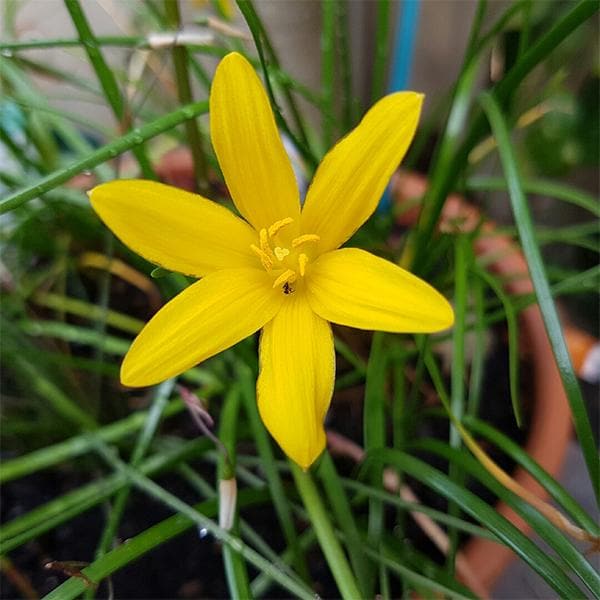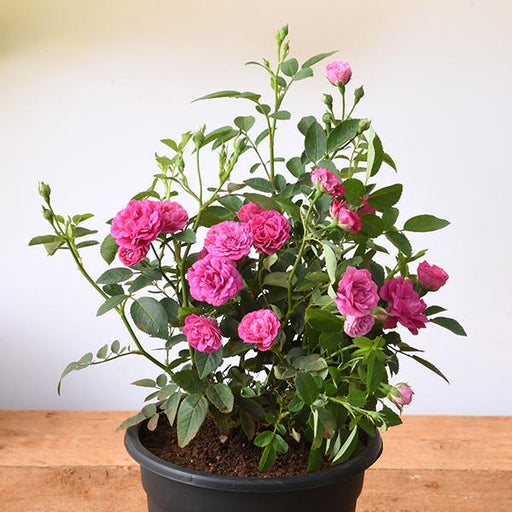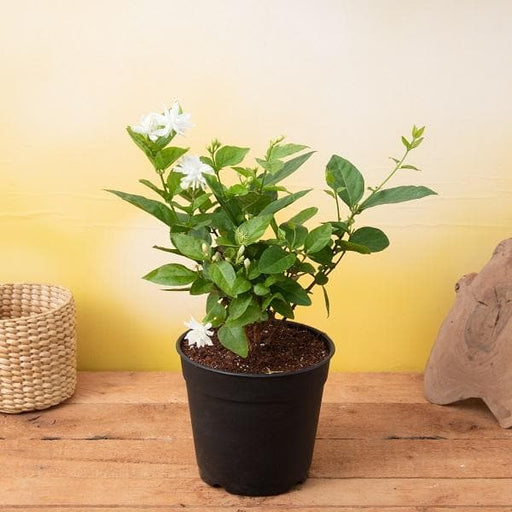
Zephyranthes Citrina (Yellow) - Plant
(MRP Inclusive of all taxes)
- Shipping ₹79 for entire order
- Dispatch in 7 days
- Country of origin: India

(MRP Inclusive of all taxes)
 Save 29%
Save 29%
Air Purifier Money Plant with Pot The Air Purifier Money Plant, also known as Pothos or Epipremnum aureum, is a stunning indoor plant that...
View full details
 Save up to 15%
Save up to 15%
Peace Lily, Spathiphyllum - Plant The Peace Lily, scientifically known as Spathiphyllum, is a stunning houseplant celebrated for its elegant white...
View full details
 Save 25%
Save 25%
Jasminum sambac, Mogra, Arabian Jasmine - Plant Jasminum sambac, commonly known as Mogra or Arabian Jasmine, is a fragrant flowering plant...
View full details
 Save 18%
Save 18%
Combo Constituents Includes the Parijat Tree (Night-Flowering Jasmine), a culturally significant plant with fragrant flowers. Description The Pari...
View full details
 Save 25%
Save 25%
Miniature Rose, Button Rose (Any Color) - Plant The Miniature Rose, also known as the Button Rose, is a charming and compact flowering plant that ...
View full details Save 25%
Save 25%
Damascus Rose, Scented Rose (Any Color) - Plant The Damascus Rose, also known as Rosa damascena, is a timeless symbol of beauty and romanc...
View full details
 Save 17%
Save 17%
Beautiful Fragrant Mogra, Arabian Jasmine Plant with Pot The Beautiful Fragrant Mogra, also known as Arabian Jasmine (Jasminum sambac), is...
View full details Save 15%
Save 15%
Pack of Vermicompost and Neem Cake for House Plants Transform your indoor garden with our premium Pack of Vermicompost and Neem Cake, spec...
View full details
Pack of Plant Growth and Flower Boosters Unlock the full potential of your garden with our Pack of Plant Growth and Flower Boosters! This ...
View full details Save 38%
Save 38%
Combo of Jeevamrut and Neem Raksha for Easy Growth and Protection of Houseplants Transform your indoor garden with our exclusive combo of ...
View full details Save 22%
Save 22%
Plant Nutrients Kit (Pack of 16) for a Healthy Garden Transform your garden into a lush paradise with our Plant Nutrients Kit, featuring 1...
View full details Save 16%
Save 16%
Combo of Top Plant Fertilizers Elevate your gardening game with our exclusive Combo of Top Plant Fertilizers, featuring two bags of premiu...
View full details Save 24%
Save 24%
Pack of 4 Additives to Make Soil Healthy and Nutrient Rich Transform your garden into a thriving ecosystem with our Pack of 4 Additives de...
View full details Save 30%
Save 30%
Transform your gardening experience with our premium Combo of Perlite and Vermiculite. This unique blend is designed to enhance soil aeration and ...
View full details Save 27%
Save 27%
Combo of 2 Vermicompost and Cocopeat - Enrich Your Soil Naturally! Transform your garden into a thriving ecosystem with our Combo of 2 Ver...
View full details
 Save 35%
Save 35%
Best 6 Plants for Perfect Indoor Garden Transform your living space into a lush oasis with our curated collection of the Best 6 Plants for a...
View full details
 Save up to 50%
Save up to 50%
Mini Succulent Garden Pack Transform your space with our Mini Succulent Garden Pack, featuring a delightful collection of 4 any variety beautiful s...
View full details
 Save 30%
Save 30%
5 Best Fragrant Plants Transform your garden or indoor space into a fragrant paradise with our curated selection of the 5 Best Fragrant Plants. Th...
View full details
 Save 24%
Save 24%
Set of 2 Bonsai Looking Grafted Adeniums Transform your indoor or outdoor space with our exquisite Set of 2 Bonsai Looking Grafted Adenium...
View full details Save 45%
Save 45%
Top 4 Die Hard Succulents Pack Transform your indoor or outdoor space with our Top 4 Die Hard Succulents Pack, featuring a curated selecti...
View full details
 Save 30%
Save 30%
5 Best Indoor Plants Pack Transform your living space into a lush oasis with our '5 Best Indoor Plants Pack.' This carefully curated collection fe...
View full details
 Save 25%
Save 25%
Set of 4 Evergreen Air Purifier Plant Pack Transform your indoor space into a lush, green oasis with our Set of 4 Evergreen Air Purifier Pla...
View full details| SrNo | Item Name | Qty |
|---|---|---|
| 1 | Zephyranthes Citrina (Yellow) Plant in 6 inch (15 cm) Pot | 1 |
The Zephyranthes Citrina, commonly known as the Yellow Rain Lily, is a stunning perennial bulb native to the grasslands of South America. This charming plant produces vibrant yellow flowers that bloom in late summer, creating a delightful display in gardens and landscapes. With its ability to thrive in various soil types and conditions, the Yellow Rain Lily is an excellent choice for both novice and experienced gardeners.
What makes Zephyranthes Citrina special is its resilience and adaptability. This plant not only adds a splash of color to your garden but also attracts pollinators like bees and butterflies, contributing to local biodiversity. Its unique ability to bloom after rainfall makes it a symbol of hope and renewal in many cultures.
One of the standout features of the Yellow Rain Lily is its low maintenance requirements. It can flourish in full sun to partial shade, making it versatile for different garden settings. Additionally, its drought-tolerant nature means it can survive in dry spells, making it an eco-friendly choice for sustainable gardening.
Zephyranthes Citrina plays a vital role in supporting local ecosystems by attracting pollinators and providing habitat for beneficial insects. Its drought-resistant nature also contributes to water conservation efforts, making it a sustainable choice for environmentally conscious gardeners.
If you think caring for plants is as easy as watering your houseplant once a month, think again! Zephyranthes Citrina, or the charming yellow rain lily, requires a bit more finesse. These beauties thrive in well-drained soil and love a sunny spot. Just remember, too much water is their kryptonite. Treat them right, and they’ll reward you with a dazzling display of yellow blooms that’ll make your neighbors green with envy.
Fasten your seatbelts, because Zephyranthes Citrina is not one to dawdle! This plant has a growth rate that can make your head spin. With the right conditions, you’ll see those lovely yellow flowers popping up in no time. Just be sure to give them enough sunlight and a little love, and they’ll grow faster than you can say “green thumb.”
Soil, glorious soil! For Zephyranthes Citrina, the right soil is like a five-star hotel. They prefer well-draining soil that allows their roots to breathe. A mix of sandy loam with a touch of organic matter will have them feeling like royalty. Remember, soggy roots are a no-go, so keep that soil dry and watch your plant thrive!
Sunlight is the secret sauce for Zephyranthes Citrina. These little sun worshippers crave bright, direct light to flourish. If you’re thinking of placing them in a shady corner, think again! They’ll sulk and refuse to bloom. Give them a sunny spot, and they’ll reward you with a burst of yellow that’ll brighten your day.
Watering Zephyranthes Citrina is like a delicate dance. Too much, and you’ll drown them; too little, and they’ll wither away. Aim for a watering schedule that keeps the soil slightly moist but never soggy. During their growing season, a weekly splash should do the trick. Just remember, they prefer to be on the dry side, so don’t go overboard!
Fertilizing Zephyranthes Citrina is like giving them a gourmet meal. A balanced, slow-release fertilizer during the growing season will keep them happy and healthy. Just don’t go crazy; a little goes a long way! Over-fertilizing can lead to more problems than a soap opera, so stick to the recommended dosage and watch your plants thrive.
Pests are the uninvited guests at the plant party, but fear not! Zephyranthes Citrina can handle a few nuisances with a little help. Keep an eye out for aphids and spider mites, and if they crash the party, a gentle spray of insecticidal soap will send them packing. Regular checks will keep your yellow beauties pest-free and fabulous.
Want to multiply your Zephyranthes Citrina? Propagation is the name of the game! These plants can be easily propagated through bulbs. Just dig them up, separate the bulbs, and replant them in well-draining soil. With a little patience and care, you’ll have a whole army of yellow blooms in no time, ready to take over your garden!
Get ready for a floral fiesta! Zephyranthes Citrina typically blooms in late summer to early fall, but they can surprise you with a few off-season blooms if they’re feeling particularly generous. Their bright yellow flowers are like little rays of sunshine, bringing joy to your garden. Just be sure to give them the right conditions, and they’ll keep the party going!
Pairing Zephyranthes Citrina with the right companions can create a garden masterpiece. Think of them as the life of the party, best complemented by other drought-tolerant plants like succulents or ornamental grasses. Together, they’ll create a stunning display that’ll have your garden looking like a botanical wonderland. Just make sure they all enjoy similar sunlight and watering needs!
Incorporating Zephyranthes Citrina into your landscape design is like adding a splash of sunshine to a canvas. Their vibrant yellow blooms can brighten up any garden bed or border. Use them as focal points or in clusters for a dramatic effect. With their low maintenance needs, they’re the perfect choice for busy gardeners who still want a stunning outdoor space.
Zephyranthes Citrina, also known as the Yellow Rain Lily, is a charming little bulbous plant that blooms bright yellow flowers. It’s like a sunbeam in your garden, bringing joy and color. Perfect for those who want a splash of sunshine without the fuss of high maintenance!
Caring for this sunny plant is a breeze! Just plant it in well-draining soil, give it a good drink during dry spells, and let it bask in full sun. It’s like a vacation for your plant—minimal effort, maximum reward!
This delightful plant typically blooms in late spring to early summer, but it can surprise you with a few off-season blooms. It’s like that friend who shows up uninvited but brings cake—always a welcome surprise!
Plant it in a sunny spot with well-draining soil, and watch it thrive! It loves to soak up the sun, so think of it as your garden’s little sunbather, soaking in those rays and showing off its vibrant blooms.
Yes, indeed! Zephyranthes Citrina is a perennial, meaning it will return year after year, like that one friend who never leaves the party. Just give it some love, and it’ll keep coming back with its sunny disposition!
Absolutely! This plant is a pot superstar. Just ensure the pot has good drainage, and it’ll thrive on your patio or balcony. It’s like having a little piece of sunshine wherever you go!
Water it when the soil feels dry, but don’t drown it! Think of it as a delicate dance—too much water, and it’ll be a soggy mess; too little, and it’ll be thirsty. Find that sweet spot for happy blooms!
Yes, this plant is not on the deer’s menu! They tend to skip over it, making it a great choice for gardens where deer roam. It’s like having a secret weapon against those pesky nibblers!
While generally pest-resistant, watch out for aphids and spider mites. They can be like uninvited guests at a party. A quick spray of insecticidal soap will send them packing, keeping your plant happy and healthy!
Yes, you can! Propagation is as easy as pie. Just divide the bulbs during the dormant season, and you’ll have new plants sprouting up like popcorn. It’s a fun way to expand your sunny garden!
This plant thrives in full sun and well-draining soil. It loves warmth and doesn’t mind a little drought. Think of it as the sun-loving beachgoer of the plant world—just give it the right conditions, and it’ll flourish!